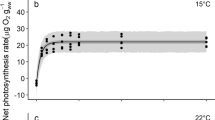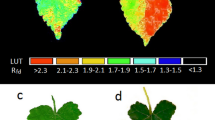Abstract
PAM (Pulse Amplitude Modulation) fluorometer techniques directly measure the light reactions of photosynthesis that are otherwise difficult to estimate in CAM (Crassulacean Acid metabolism) plants such as pineapple (Ananas comosus comosus cv. Phuket). PAM machines calculate photosynthesis as the Electron Transport Rate (ETR) through PSII (4 electrons per O2 produced) as mol m−2 s−1. P vs. E curves fitted the waiting-in-line function (an equation of the form \( {\hbox{ETR}} = \left( {{\hbox{ET}}{{\hbox{R}}_{{ \max }}} \times {\hbox{E}}/{{\hbox{E}}_{\rm{opt}}}} \right).{{\hbox{e}}^{{1} - {\rm{E}}/{\rm{Eopt}}}} \)) allowing half-saturating and optimal irradiances (Eopt) to be estimated. Effective Quantum Yield (Ymax), Electron Transport Rate (ETRmax) and the Non-Photochemical Quenching parameter, NPQmax all vary on a diurnal cycle but the parameter qNmax does not show a systematic variation over a diurnal period. Phuket pineapple is a “sun plant” with Optimum Irradiance (Eopt) from 755 to 1,130 μmol m−2 s−1 (400–700 nm) PAR but photosynthetic capacity is very low in the late afternoon even though light conditions are favourable for rapid photosynthesis. Total CO2 fixed nocturnally as C4-dicarboxylic acids by leaves of the Phuket pineapple was only ≈0.14 gC m−2 d−1 (0.012 mol C m−2 d−1). Titratable acid of leaves was depleted about 3 pm (15:00) and shows a classical CAM diurnal cycle. The Phuket pineapple variety only stored enough CO2 as C4 acids to account for only about 2.5% of photosynthesis (Pg) estimated using the PAM machine (≈5.6 gC m−2 d−1). Phuket pineapples are classifiable as CAM-Cycling plants but nocturnal fixation of CO2 is so low compared to the more familiar Smooth Cayenne variety that it probably recycles only a small proportion of the respiratory CO2 produced in leaves at night and so even CAM-cycling is only of minor importance to the carbon economy of the plant. Unlike the Smooth Cayenne pineapple variety, which fixes large amounts of CO2 nocturnally, the Phuket pineapple is for practical purposes a C3 plant.








Similar content being viewed by others
Abbreviations
- α:
-
Photosynthetic efficiency
- E:
-
Irradiance (mol m−2 s−1) PAR
- Eopt :
-
Optimum irradiance for maximum photosynthesis
- ETR:
-
Electron transport rate
- PAM:
-
Pulse Amplitude Modulation fluorometry
- PAR:
-
Photosynthetically Active Radiation (400–700 nm) (sometimes alternatively termed Photosynthetic Photon Flux Density PPFD)
- Pg :
-
Gross photosynthesis
- PSI:
-
Photosystem I
- PSII:
-
Photosystem II
References
Björkman O, Demmig B (1987) Photon yield of O2 evolution and chlorophyll fluorescence characteristics at 77K among vascular plants of diverse origins. Planta 170:489–504
Broetto F, Duarte HM, Lüttge U (2007) Responses of chlorophyll fluorescence parameters of the facultative halophyte and C3–CAM intermediate species Mesembryanthemum crystallinum to salinity and high irradiance stress. J Plant Physiol 164:904–912
Chen L-S, Lin Q, Nose A (2002) A comparative study on diurnal changes in metabolite levels in the leaves of three crassulacean acid metabolism (CAM) species, Ananas comosus, Kalanchoë daigremontiana and K. pinnata. J Exp Bot 367:341–350
Cote FX, Andre M, Folliot M, Massimino D, Daquenet A (1989) CO2 and O2 exchanges in the CAM plant Ananas comosus (L.) Merr. determination of total and malate-decarboxylation-dependent C02-assimilation rates; study of light O2-uptake. Plant Physiol 89:61–68
Cushman JC, Borland AM (2002) Induction of crassulacean acid metabolism by water limitation. Plant Cell Environ 25:297–312
Dodd AN, Borland AM, Haslam RP, Griffiths H, Maxwell K (2002) Crassulacean acid metabolism: plastic fantastic. J Exp Bot 369:569–580
Duarte HM, Lüttge U (2007) Circadian rythmicity. In: Lüttge U (ed) Clusia: a woody Neotropical genus of remarkable plasticity and diversity, chapter 11, 2nd edn. Springer-Verlag, Berlin, pp 245–256
Franco AC, Haag-Kerwer A, Herzog B, Grams TEE, Ball E, de Mattos EA, Scarano FR, Barreto S, Garcia MA, Mantovani A, Lüttge U (1996) The effect of light levels on daily patterns of chlorophyll fluorescence and organic acid accumulation in the tropical CAM tree Clusia hilariana. Trees 10:359–365
Franco AC, Herzog B, Hübner C, de Mattos EA, Scarano FR, Ball E, Lüttge U (1999) Diurnal changes in chlorophyll a fluorescence, CO2-exchange and organic acid decarboxylation in the tropical CAM tree Clusia hilariana. Tree Physiol 19:635–644
Franklin LA, Badger MR (2001) A comparison of photosynthetic electron transport rates in macroalgae measured by pulse amplitude modulated chlorophyll fluorometry and mass spectroscopy. J Phycol 37:756–767
Genty B, Briantais JM, Baker NR (1989) The relationship between the quantum yield of photosynthetic electron transport and quenching of chlorophyll fluorescence. Biochim Biophys Acta 990:87–92
Griffiths H, Helliker B, Roberts A, Haslam RP, Girnus J, Robe WE, Borland AM, Maxwell K (2002) Regulation of RUBISCO in crassulacean acid metabolism plants: better late than never. Funct Plant Biol 29:689–696
Griffiths H, Robe WE, Girnus J, Maxwell K (2008) Leaf succulence determines the interplay between carboxylase systems and light use during Crassulacean acid metabolism in Kalanchoë species. J Exp Bot 59:1851–1861
Gueymard C (1995) SMARTS, A Simple Model of the Atmospheric Radiative Transfer of Sunshine: algorithms and performance assessment. Professional paper FSEC-PF-270-95, Florida Solar Energy Center, 1679 Clearlake Rd., Cocoa, FL, USA 32922
Gueymard CA, Myers D, Emery K (2002) Proposed reference irradiance spectra for solar energy systems testing. Sol Energy 73:443–467
Hartsock TL, Nobel PS (1976) Watering converts a CAM plant to daytime CO2 uptake. Nature 262:574–576
Herppich WB, Midgley GF, Herppich M, Tüffers A, Veste M, von Willert DJ (1998) Interactive effects of photon fluence rates and drought on CAM-cycling in Delosperma tradescantioides (Mesembryanthemaceae). Physiol Plant 102:148–154
Hew CS, Khoo SL (1980) Photosynthesis of young orchid seedlings. New Phytol 86:349–357
Hew CS, Yong JWH (2004) The physiology of tropical orchids in relation to the industry, 2nd edn. World Scientific, Singapore
Holt NE, Fleming GR, Niyogi NK (2004) Toward an understanding of the mechanism of non-photochemical quenching in green plants. Biochemistry 43:8281–8289
Krause GH, Weis E (1991) Chlorophyll fluorescence and photosynthesis: the basics. Annu Rev Plant Physiol 42:313–349
Lüttge U (2004) Ecophysiology of Crassulacean Acid Metabolism (CAM). Ann Bot 93:629–652
Lüttge U (2007) Photosynthesis. In: Lüttge U (ed) Clusia: a woody Neotropical genus of remarkable plasticity and diversity, chapter 8, 2nd edn. Springer-Verlag, Berlin, pp 135–186
Malda G, Backhaus RA, Martin C (1999) Alterations in growth and crassulacean acid metabolism (CAM) activity of in vitro cultured cactus. Plant Cell Tiss Org 58:1–9
Martin CE, Tüffers A, Herppich WB, von Willert DJ (1999) Utilization and dissipation of absorbed light energy in the epiphytic crassulacean acid metabolism Bromeliad Tillandsia ionantha. Int J Plant Sci 160:307–313
Martyn AJ, Larkum AWD, McConchie R, Offord CA (2008) Photoinhibition and changes in pigments associated with bract browning in waratahs (Telopea spp., Proteaceae). J Hortic Sci Biotechnol 83:367–373
Maxwell K, Badger MR, Osmond CB (1998) A comparison of CO2 and O2 exchange patterns and the relationship with chlorophyll fluorescence during photosynthesis in C3 and CAM plants. Aust J Plant Physiol 25:45–52
Mc Williams EL (1970) Comparative rates of dark CO2 uptake and acidification in the Bromeliaceae, Orchidaceae, and Euphorbiaceae. Bot Gaz 131:285–290
Medina E, Popp M, Olivares E, Janett H-P, Lüttge U (1993) Daily fluctuations of titratable acidity, content of organic acids (malate and citrate) and soluble sugars of varieties and wild relatives of Ananas comosus L. growing under natural tropical conditions. Plant Cell Environ 16:55–63
Melis A (1989) Spectroscopic methods in photosynthesis: photosystem stoichiometry and chlorophyll antenna size. Phil Trans R Soc Lond B 323:397–409
Nievola CC, Kraus JE, Freschi L, Souza BM, Mercier H (2005) Temperature determines the occurrence of CAM or C3 photosynthesis in pineapple plantlets grown in vitro. In Vitro Cell Dev Biol-Plant 41:832–837
O’Neill PM, Shanahan JF, Schepers JS (2006) Use of chlorophyll fluorescence assessments to differentiate corn hybrid response to variable water conditions. Crop Sci 46:681–687
Osmond CB (1978) Crassulacean acid metabolism: curiosity in context. Annu Rev Plant Physiol 29:379–414
Patel A, Ting IP (1987) Relationship between respiration and CAM-Cycling in Peperomia camptotricha. Plant Physiol 84:640–642
Ralph PJ, Gademann R (2005) Rapid light curves: a powerful tool to assess photosynthetic activity. Aquat Bot 82:222–237
Rascher U, Liebig M, Lüttge U (2000) Evaluation of instant light-response curves of chlorophyll fluorescence parameters obtained with a portable chlorophyll fluorometer on site in the field. Plant Cell Environ 23:1398–1405
Ritchie RJ (2006) Consistent sets of spectrophotometric equations for acetone, methanol and ethanol solvents. Photosynth Res 89:27–41
Ritchie RJ (2008) Fitting light saturation curves measured using PAM fluorometry. Photosynth Res 96:201–215
Ritchie RJ, Bunthawin S (2010) The use of PAM (Pulse Amplitude Modulation) fluorometry to measure photosynthesis in a CAM orchid, Dendrobium spp. (D. ‘Viravuth’ Pink). Int J Plant Sci 171:575–585
Schreiber U, Bilger W, Neubauer C (1995a) Chlorophyll fluorescence as a non-intrusive indicator for rapid assessment of in vivo photosynthesis. In: Schulze ED, Caldwell MM (eds) Ecophysiology of photosynthesis. Ecological studies, vol. 100. Springer-Verlag, Berlin, pp 49–70
Schreiber U, Endo T, Mi H-L, Asada K (1995b) Quenching analysis of chlorophyll fluorescence by the saturation pulse method: particular aspects relating to the study of eukaryotic algae and cyanobacteria. Plant Cell Physiol 36:873–882
Silvera K, Santiago LS, Cushman JC, Winter K (2009) Crassulacean acid metabolism and epiphytism linked to adaptive radiations in the Orchidaceae. Plant Physiol 149:1838–1847
Sipes DL, Ting IP (1985) Crassulacean acid metabolism and crassulacean acid metabolism modifications in Peperomia camptotricha. Plant Physiol 77:59–63
Slesak I, Karpinska B, Surówka E, Miszalski Z, Karpinski S (2003) Redox changes in the chloroplast and hydrogen peroxide are essential for regulation of C3–CAM transition and photooxidative stress responses in the facultative CAM plant Mesembryanthemum crystallinum L. Plant Cell Physiol 44:573–581
Taize L, Zeiger E (2002) Plant physiology. Sinauer Associates, Sunderland
Ting IP (1985) Crassulacean acid metabolism. Annu Rev Plant Physiol 36:595–622
van Kooten O, Snel JFH (1990) The use of chlorophyll fluorescence nomenclature in plant stress physiology. Photosynth Res 25:147–150
Vovides AP, Etherington JR, Dresser PQ, Groenhof A, Iglesias C, Flores J, Lüttge U (2002) CAM-cycling in the cycad Dioon edule Lindl. in its natural tropical deciduous forest habitat in central Veracruz, Mexico. Bot J Linn Soc 138:155–162
White AJ, Critchley C (1999) Rapid light curves: a new fluorescence method to assess the state of the photosynthetic apparatus. Photosynth Res 59:63–72
Winter K, Holtum JAM (2002) How closely do the δ 13C values of Crassulacean Acid Metabolism plants reflect the proportion of CO2 fixed during day and night? Plant Physiol 129:1843–1851
Winter K, Garcia M, Holtum JAM (2008) On the nature of facultative and constitutive CAM: environmental and developmental control of CAM expression during early growth of Clusia, Kalanchoë, and Opuntia. J Exp Bot 59:1829–1840
Zhu J, Goldstein G, Bartholomew DP (1999) Gas exchange and carbon isotope composition of Ananas comosus in response to elevated CO2 and temperature. Plant Cell Environ 22:999–1007
Acknowledgements
This project was funded as part of an Endeavour Executive Award (1324_2009) awarded to the author by the Department of Education and Training, Commonwealth of Australia. The author wishes to thank Prince Songkla University—Phuket for providing facilities for the project and Prof Puwadon Butrat for his interest in the project.
Author information
Authors and Affiliations
Corresponding author
Additional information
Communicated by: Paul Moore
Rights and permissions
About this article
Cite this article
Ritchie, R.J., Bunthawin, S. Photosynthesis in Pineapple (Ananas comosus comosus [L.] Merr) Measured Using PAM (Pulse Amplitude Modulation) Fluorometry. Tropical Plant Biol. 3, 193–203 (2010). https://doi.org/10.1007/s12042-010-9057-y
Received:
Accepted:
Published:
Issue Date:
DOI: https://doi.org/10.1007/s12042-010-9057-y




